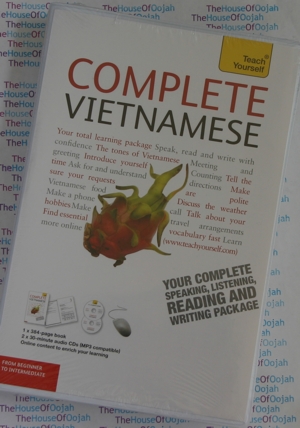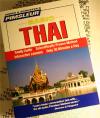Teach Yourself Complete Vietnamese Book and 2 Audio CDs NEW

Teach Yourself Complete Vietnamese2 Audio CDs and Book |
 |
Teach Yourself Complete Vietnamese 2 Audio CDs and Book2 CD's and Book
Are you looking for a complete course in Vietnamese which takes you effortlessly from beginner to confident speaker? Whether you are starting from scratch, or are just out of practice, Complete Vietnamese will guarantee success! Now fully updated to make your language learning experience fun and interactive. You can still rely on the benefits of a top language teacher and our years of teaching experience, but now with added learning features within the course and online. The course is structured in thematic units and the emphasis is placed on communication, so that you effortlessly progress from introducing yourself and dealing with everyday situations, to using the phone and talking about work. By the end of this course, you will be at Level B2 of the Common European Framework for Languages: Can interact with a degree of fluency and spontaneity that makes regular interaction with native speakers quite possible without strain for either party.Learn effortlessly with a new easy-to-read page design and interactive features: NOT GOT MUCH TIME? AUTHOR INSIGHTS GRAMMAR TIPS USEFUL VOCABULARY DIALOGUES PRONUNCIATION TEST YOURSELF EXTEND YOUR KNOWLEDGE TRY THIS * Level - suitable for both the complete beginner and the person who wants to brush up existing knowledge Table of Contents: About the Author Dana Healy:
About the Vietnamese LanguageVietnamese, formerly known under French colonization as Annamese , is the national and official language of Vietnam. It is the mother tongue of the Vietnamese people , who constitute 86% of Vietnam's population, and of about three million overseas Vietnamese, most of whom live in the United States. It is also spoken as a second language by some ethnic minorities of Vietnam. It is part of the Austroasiatic language family, of which it has the most speakers by a significant margin (several times larger than the other Austroasiatic languages put together). Much vocabulary has been borrowed from Chinese, and it was originally written using the Chinese writing system. The Vietnamese writing system in use today is an adapted version of the Latin alphabet, with additional diacritics for tones and certain letters. It seems likely that in the distant past Vietnamese shared more characteristics common to other languages in the Austroasiatic family, such as an inflectional morphology and a richer set of consonant clusters, which have subsequently disappeared from the language. However, Vietnamese appears to have been heavily influenced by its location in the Southeast Asian sprachbund—with the result that it has acquired or converged toward characteristics such as isolating morphology and tonogenesis. These characteristics, which may or may not have been part of proto-Austroasiatic, nonetheless have become part of many of the phylogenetically unrelated languages of Southeast Asia—for example, Thai (one of the Tai-Kadai languages), Tsat (a member of the Malayo-Polynesian group within Austronesian), and Vietnamese each developed tones as a phonemic feature, although their respective ancestral languages were not originally tonal.[citation needed] The Vietnamese language has similarities with Cantonese in regard to the specific intonations and unreleased plosive consonant endings, a legacy of archaic Chinese. The ancestor of the Vietnamese language was originally based in the area of the Red River in what is now northern Vietnam, and during the subsequent expansion of the Vietnamese language and people into what is now central and southern Vietnam (through conquest of the ancient nation of Champa and the Khmer people of the Mekong delta in the vicinity of present-day Ho Chi Minh City), Vietnamese was linguistically influenced primarily by Chinese, which came to predominate politically in the 2nd century B.C.E. With the rise of Chinese political dominance came radical importation of Chinese vocabulary and grammatical influence. As Chinese was, for a prolonged period, the only medium of literature and government, as well as the primary written language of the ruling class in Vietnam, much of the Vietnamese lexicon in all realms consists of Hán Việt (Sino-Vietnamese) words. In fact, as the vernacular language of Vietnam gradually grew in prestige toward the beginning of the second millennium, the Vietnamese language was written using Chinese characters (using both the original Chinese characters, called Hán tự, as well as a system of newly created and modified characters called Chữ nôm) adapted to write Vietnamese, in a similar pattern as used in Japan (kanji), Korea (hanja), and other countries in the Sinosphere. The Nôm writing reached its zenith in the 18th century when many Vietnamese writers and poets composed their works in Chữ Nôm, most notably Nguyễn Du and Hồ Xuân Hương (dubbed "the Queen of Nôm poetry"). As contact with the West grew, the Quốc Ngữ system of Romanized writing was developed in the 17th century by Portuguese and other Europeans involved in proselytizing and trade in Vietnam. When France invaded Vietnam in the late 19th century, French gradually replaced Chinese as the official language in education and government. Vietnamese adopted many French terms, such as đầm (dame, from madame), ga (train station, from gare), sơ mi (shirt, from chemise), and búp bê (doll, from poupée). In addition, many Sino-Vietnamese terms were devised for Western ideas imported through the French. However, the Romanized script did not come to predominate until the beginning of the 20th century, when education became widespread and a simpler writing system was found more expedient for teaching and communication with the general population. |
Teach Yourself Complete Vietnamese 2 Audio CDs and Book |
| Stock Info: | Out of Print |

 0 Items (Empty)
0 Items (Empty)

